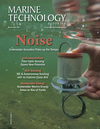
Page 28: of Marine Technology Magazine (March 2021)
Oceanographic Instrumentation & Sensors
Read this page in Pdf, Flash or Html5 edition of March 2021 Marine Technology Magazine
AUV Docking
ISE’s prototype dock being towed on the surface
All images courtesy International Submarine Engineering
Typically, the AUV deploys a ? oat and line that is used by He has just received the ? rst data packet from the AUV. It has the operators to bring the AUV closer to the ship. This can be successfully acquired the dock’s acoustic signature using its very challenging in harsh seas and there is a risk of the line forward looking multibeam echosounder. This is nothing new fouling with the AUV control planes and thruster. Once close for the project, and at this point the AUV has repeatedly com- enough, the AUV has to mate with a ship that is often pitching pleted this stage of its mission at ranges up to 100 meters as and rolling. This stage is extremely dangerous as the recovery part of ISE’s testing plan. That said, it is still a big milestone. It infrastructure can easily end up impacting the AUV. As the means that the AUV has ? ltered out the strong acoustic returns waves get bigger, so do the dangers. in its ? eld of view and has identi? ed one that meets the criteria
With subsea docking that AUV can make the connection and has adjusted its heading to approach. It must be able to do with the ship infrastructure beneath the waves. This increases this on its own as communication with the surface is so limited.
mission endurance by allowing operators to recharge and re- “Range 8 meters. It’s switched to visual tracking.” Jason task the vehicle without having to risk these potentially dan- again reads data from the AUV at the next important mile- gerous recoveries. stone. The AUV has assessed that the quality of visual track-
There is also an additional bene? t: if the docking can be au- ing is good enough to switch away from acoustic tracking. tonomous it can be solely supported by a large Uncrewed Sur- It can now see the light array on the dock and is using it to face Vessel (USV). This radically changes the AUV’s mission calculate the dock relative position, speed, and attitude. This capability and by removing a crewed surface ship, the costs capability took months to develop using techniques such as are signi? cantly reduced. With the AUV and USV paired like computational neural networks to train the vehicle to recog- this their mission endurance can be measured in weeks - not nise the LEDs and array being used.
hours - and they can both be launched from shore. When deciding on the dock design, ISE opted to make it as
IDEaS has a keen interest in persistent maritime surveil- simple and as passive as possible, taking a similar approach to lance; the Department of National Defense want to know aircraft in-? ight refueling. The reason being that the AUV is what is entering their waters. As there is such a vast Canadian already a very capable and maneuverable vehicle. Designing coastline needing to be monitored, new thinking is required a complex system that required a pilot to aid the docking pro- to ? nd the best solution. Having a USV and AUV working cess wasn’t in the spirit of what they were trying to achieve. together could be it. The resulting dock was designed to be a stable platform with a half meter target cone. As long as the AUV impacts within
ACOUSTIC AND VISUAL TRACKING this cone, the dock will self-align and aid the process. It was “Range 26 meters. On acoustics.” Jason, one of ISE’s electri- also designed with a two-part tow cable to help decouple the cal engineers, breaks the silence on the bridge of Researcher. dock movement from the surface waves.
28 March/April 2021
MTR #3 (18-33).indd 28 3/22/2021 9:47:40 PM

 27
27

 29
29
